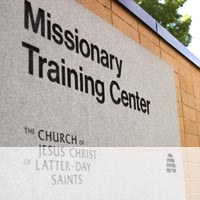Difference between revisions of "Missionary Training Center"
| Line 2: | Line 2: | ||
| − | '''Missionary Training Centers''', or MTCs, are maintained by [[The Church of Jesus Christ of Latter-day Saints]] to train their full-time [http://www.lightplanet.com/mormons/daily/missionary/index.htm missionaries] before sending them around the world. They are trained in expected conduct | + | '''Missionary Training Centers''', or MTCs, are maintained by [[The Church of Jesus Christ of Latter-day Saints]] to train their full-time [http://www.lightplanet.com/mormons/daily/missionary/index.htm missionaries] before sending them around the world. They are trained in expected conduct, and where required, a foreign language. All missionaries are given at least three weeks' instruction in proselyting methods. This includes lessons on church doctrine and teaching, proper manners, and on non-confrontational behavior. They are encouraged to actively study the Church's doctrine in order to receive inspiration on how best to teach and help others. Almost all missionaries attend at least one of the MTCs for training prior to serving in their assigned area. |
There are currently seventeen MTCs, in the following locations: | There are currently seventeen MTCs, in the following locations: | ||
Revision as of 21:45, 8 July 2008
Missionary Training Centers, or MTCs, are maintained by The Church of Jesus Christ of Latter-day Saints to train their full-time missionaries before sending them around the world. They are trained in expected conduct, and where required, a foreign language. All missionaries are given at least three weeks' instruction in proselyting methods. This includes lessons on church doctrine and teaching, proper manners, and on non-confrontational behavior. They are encouraged to actively study the Church's doctrine in order to receive inspiration on how best to teach and help others. Almost all missionaries attend at least one of the MTCs for training prior to serving in their assigned area.
There are currently seventeen MTCs, in the following locations:
- Provo, Utah (USA)
- Preston, England
- Buenos Aires, Argentina
- Sao Paulo, Brazil
- Mexico City, Mexico
- Santiago, Chile
- Bogotá, Colombia
- Lima, Peru
- Guatemala City, Guatemala
- Hamilton, New Zealand
- Manila, Philippines
- Tokyo, Japan
- Seoul, South Korea
- Santo Domingo, Dominican Republic
- Madrid, Spain
- Accra, Ghana
- Johannesburg, South Africa
Regardless of the particular MTC attended, all missionaries are given the chance to further learn the doctrines of Jesus Christ and to develop and strengthen Christlike attributes. Missionaries learn to teach principles with clarity and to help others have faith in Christ, repent, be baptized in Christ's name, receive the Holy Spirit, and continue in the ways of Christ. Because many missionaries are sent to countries or areas where a different language is spoken, Missionary Training Centers provide important instruction on speaking foreign languages. The Provo MTC, for example, teaches almost fifty languages.
The Missionary Training Center was originally started by the Mormon Church to provide language training and a place to stay until difficulties in obtaining passport visas to their assigned areas could be cleared up.
Originally called the "Language Training Mission," the name was changed to the "Missionary Training Center" in the 1970s. The name was changed to note that it was for more than just language training, although language training would still continue to be an important part of the facility's function.
External Links
- The Provo MTC website
- About Mormonism - contains many facts about missionaries and their training.

